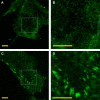Is the mechanical activity of epithelial cells controlled by deformations or forces?
- PMID: 16214867
- PMCID: PMC1367004
- DOI: 10.1529/biophysj.105.071217
Is the mechanical activity of epithelial cells controlled by deformations or forces?
Abstract
The traction forces developed by cells depend strongly on the substrate rigidity. In this letter, we characterize quantitatively this effect on MDCK epithelial cells by using a microfabricated force sensor consisting in a high-density array of soft pillars whose stiffness can be tailored by changing their height and radius to obtain a rigidity range from 2 nN/microm up to 130 nN/microm. We find that the forces exerted by the cells are proportional to the spring constant of the pillars meaning that, on average, the cells deform the pillars by the same amount whatever their rigidity. The relevant parameter may thus be a deformation rather than a force. These dynamic observations are correlated with the reinforcement of focal adhesions that increases with the substrate rigidity.
Figures



References
-
- Choquet, D., D. P. Felsenfeld, and M. P. Sheetz. 1997. Extracellular matrix rigidity causes strengthening of integrin-cytoskeletal linkages. Cell. 88:39–48. - PubMed
-
- Balaban, N. Q., U. S. Schwartz, D. Riveline, P. Goichberg, G. Tzur, I. Sabanay, D. Mahalu, S. Safran, A. Bershadsky, L. Addadi, and B. Geiger. 2001. Force and focal adhesion assembly: a close relationship studied using elastic micropatterned substrates. Nat. Cell Biol. 3:466–472. - PubMed
-
- Butler, J. P., I. M. Tolic-Norrelykke, B. Fabry, and J. J. Fredberg. 2002. Traction fields, moments, and strain energy that cells exert on their surroundings. Am. J. Physiol. Cell Physiol. 282:C595–C605. - PubMed
Publication types
MeSH terms
LinkOut - more resources
Full Text Sources

